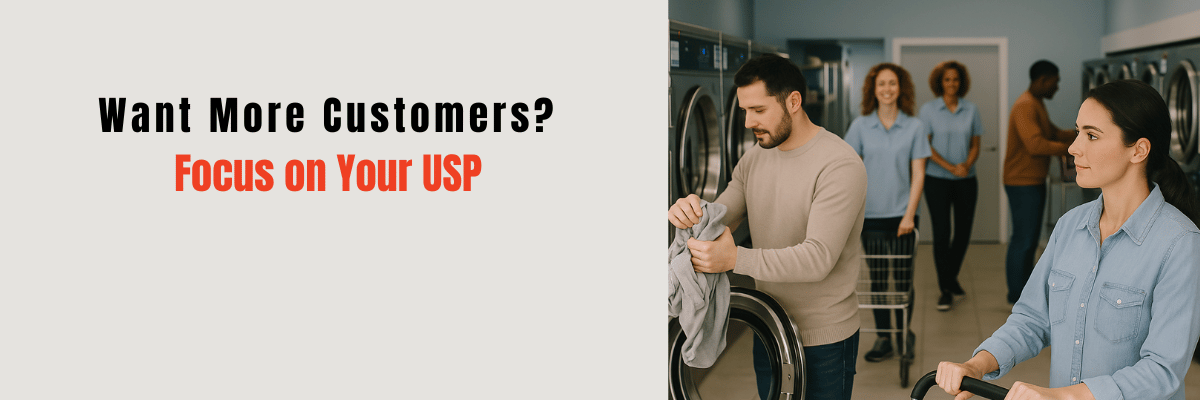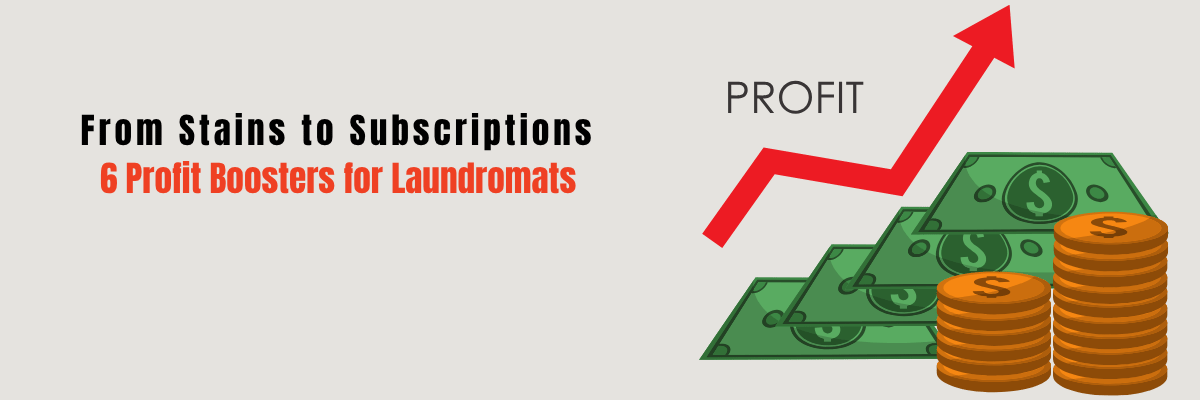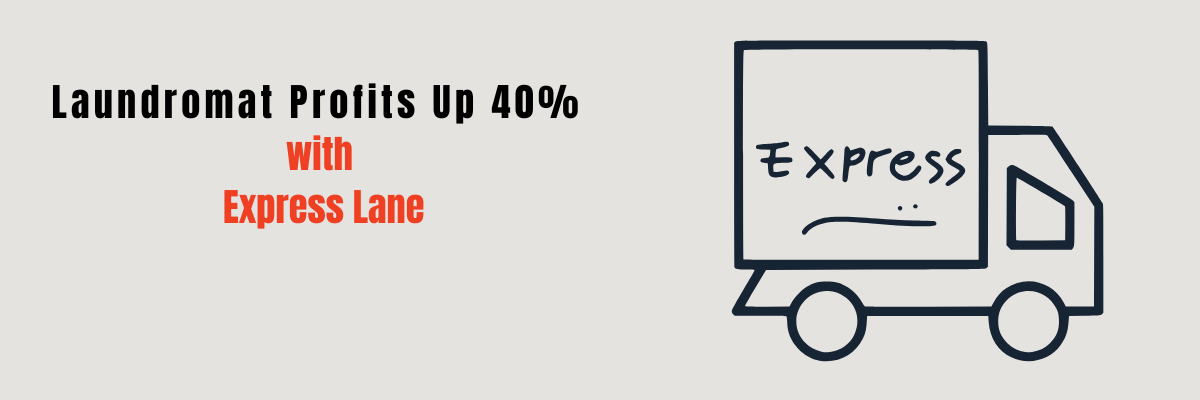6 Ways to Boost Your Laundromat Profits Without Breaking the Bank


Look, I've been in this business long enough to know that most laundromat owners are working their tails off for razor-thin margins. You're competing with the new spot down the street, dealing with busted washers at the worst possible time, and watching customers nickel-and-dime you on every service.
But here's the thing: you don't need a complete overhaul or a massive investment to seriously bump up your bottom line. I'm talking about smart moves that pay for themselves in weeks, not years.
Let me walk you through six strategies that are working right now for owners across the country. These aren't theory—they're practical plays you can start implementing tomorrow.
6 Game-Changers for Laundromat Owners to Increase Profits
1. Stain Removal Premium Service: Charge What You're Worth
Every laundromat does basic washing. But how many can get red wine out of a white tablecloth from Thanksgiving dinner? That's specialist territory, and specialists get paid.
The Setup
You don't need a chemistry degree. You need three things:
1. Basic stain removal kit ($150-200)
2. A weekend watching YouTube videos and practicing
3. Confidence to charge for your expertise
What You'll Need
Total investment: About $150
The Process That Works
When someone comes in with a gnarly stain:
1. Assess it first. Ask what caused it and when it happened. Fresh stains are way easier than set-in ones.
2. Take a photo. This is huge. Show the before and after. Build up your portfolio.
3. Be straight with them. "I can get this out, but it's gonna take some extra work. Regular wash is $3.50, but for stain treatment, we're looking at $12-15." Most people will pay it if you're confident.
4. Treat it right:
o Grease/oil: Dawn + hot water
o Wine/juice: White vinegar + cold water, then peroxide
o Blood: Hydrogen peroxide + cold water (hot sets it)
o Ink: Rubbing alcohol, blot don't rub
o Pet stains: Enzyme cleaner, let it sit 30 minutes
5. Wash it separate. Don't throw treated stuff in with regular loads.
Pricing Structure
Mike in Denver printed up a laminated card showing common stains and pricing. Hangs it right by the counter. He's pulling an extra $400-600 a month just from stain removal charges, and people think he's a miracle worker.
2. Leather and Luxury Items: The High-Margin Money Maker
Most laundromats won't touch leather jackets, wedding dresses, or designer handbags. They're scared they'll mess it up. That fear is your opportunity.
Why This Is a Gold Mine
The margins are insane because it takes knowledge and care, not expensive equipment.
Getting Started
Option 1: Learn it yourself
• Take a weekend course ($200-400). The Drycleaning & Laundry Institute offers them online now.
• Practice on your own stuff or Goodwill finds
• Start slow with items you're confident about
Option 2:
Partner up Take in the items, charge your premium price, then subcontract to a specialist cleaner. You make $20-30 per item just for being the middleman. No risk, no extra work beyond intake and delivery.
The Process for Leather
1. Inspect thoroughly. Look for tears, worn spots, hardware issues. Take photos.
2. Test in an inconspicuous spot. Always. Even if you've done 100 jackets.
3. Clean with leather cleaner and conditioner. Work in sections. Don't soak it.
4. Dry naturally. No heat, no direct sunlight. Stuff it with paper to hold shape.
5. Condition again after dry. This is what separates amateurs from pros.
The Marketing
This one's easy. Facebook Marketplace and local Facebook groups. Post: "Looking to get your leather jacket cleaned before spring? We specialize in leather care—jackets, coats, handbags. DM for pricing."
You'll get inquiries. I guarantee it.
Also, partner with local consignment shops. They always have customers asking where to get stuff cleaned. They send you business, you give them 10% or a flat $5 per referral.
3. Same-Day Service: Speed Sells
Here's the thing about same-day service: almost nobody guarantees it. Most places say "2-3 days" even when they could knock it out in one. That's your edge.
Why People Pay More for Speed
Think about it. Someone spills coffee all over their work clothes Monday morning. They need that stuff by Tuesday morning. They'll pay extra to not have to hit Target for emergency clothes.
Making It Work Without Losing Your Mind
You can't do same-day for everything, and you shouldn't. Here's the system:
Same-Day Cutoff Times:
• Orders in by 10 AM: Ready by 6 PM ($10 rush fee)
• Orders in by 2 PM: Ready by 9 PM ($15 rush fee)
• After 2 PM: Next day, regular price
The Reality Check:
Don't promise what you can't deliver. It's better to say no than to blow a deadline and lose a customer forever.
The Process
1. Set up a dedicated same-day station. Just one folding table marked "RUSH ORDERS." Keeps things organized.
2. Color-code your bags. Red mesh bags = same-day. Nobody touches those until rush orders are done.
3. Block off machines. During peak rush hours (10 AM-noon), keep 2-3 washers and dryers for same-day only.
4. Staff accordingly. You need someone on deck who can fold fast and well. Same-day with sloppy folding is worse than 2-day with neat work.
Real Numbers from Real Owners
Jenny runs a spot in Sacramento. She started offering same-day service six months ago:
• Charges $10 extra for same-day
• Averages 22 same-day orders per week
• Extra monthly revenue: $880
• Added cost: Maybe $50 in extra labor during slow periods
That's an extra $10,000+ per year with minimal changes to operations.
4. Go Green, Charge Green
The eco-friendly thing isn't just for hippies anymore. Regular folks care about this stuff now, especially younger customers and families with kids who have sensitive skin.
What "Green Cleaning" Actually Means
You don't have to get certified organic or whatever. You just need:
• Hypoallergenic detergents (free of dyes and perfumes)
• Biodegradable products
• Cold water washing when possible
• Line drying option
The Investment
Net monthly cost: About $30 Potential revenue increase: $200-400/month
How to Sell It
Put up a sign: "GREEN WASH OPTION - Better for sensitive skin, better for the planet"
Then list what you're using. People want to know specifics. Don't just say "eco-friendly"—say "We use Seventh Generation Free & Clear, no dyes, no fragrances, no harsh chemicals."
The Pricing Sweet Spot
Most folks won't pay double for green washing, but they'll pay 15-25% more without blinking:
• Regular wash-dry-fold: $1.50/lb
• Green wash option: $1.75/lb
• Premium green (organic detergent, line dry): $2.25/lb
Lisa in Portland (yeah, I know, Portland) went all-in on this. She made it her whole brand. Painted the store, changed the name to "Clean & Green Laundry," and raised prices across the board by 20%. Lost about 10% of customers but the ones who stayed spend way more. Her revenue went up 35% in the first year.
You don't have to go that hard, but even offering it as an option brings in good money.
5. Commercial Contracts: Predictable, Bulk Revenue
This is the one that changes businesses. Landing even one decent commercial contract can stabilize your whole operation.
Who Needs Your Services
• Hotels and motels: Sheets, towels, tablecloths
• Gyms and yoga studios: Towels, uniforms
• Restaurants: Tablecloths, napkins, chef coats
• Medical offices: Lab coats, scrubs, linens
• Salons and spas: Towels, capes, robes
• Daycares: Bedding, towels, staff shirts
The Numbers
Land three solid contracts and you're looking at $2,500-4,000 in recurring monthly revenue. That's before you serve a single walk-in customer.
How to Land Contracts
The Approach:
Don't cold call. Walk in. Bring a one-page proposal with:
1. Your pricing (be competitive but not desperate)
2. Pickup/delivery schedule you can commit to
3. Your turnaround time
4. A reference or two if you have them
Ask to speak with the owner or manager. Say: "I run the laundromat over on [street name]. I'm looking to take on a few commercial accounts, and I wanted to see if you're happy with your current linen service."
The Pitch:
Most commercial laundry services are massive companies that treat small businesses like an afterthought. You can compete on:
• Flexibility: "Need an extra pickup this week? No problem."
• Quality: "We inspect every item. Stained or damaged stuff gets reported, not just sent back."
• Local: "I'm five minutes away. Problem with an order? I can be here in ten minutes."
Pricing Strategy
Don't underbid by 50% thinking you'll steal business. That's amateur hour. Be competitive but not cheap:
The Contract Structure:
Keep it simple. One-page agreement:
• Services provided and pricing
• Pickup/delivery schedule
• Payment terms (net 15 or net 30)
• Quality guarantee
• 30-day cancellation clause for both parties
Start with a 90-day trial. If it works for everyone, extend it to a year.
Real Talk About Commercial Work
It's steady money, but it's work. You need systems:
1. Dedicated space: Commercial stuff doesn't mix with regular customers' clothes
2. Organized delivery: Labeled carts or bags for each account
3. Tracking: Simple spreadsheet with pounds in/out and dates
4. Backup plan: What happens if your main washer goes down on commercial day?
Tony in Chicago landed a contract with a 30-room hotel. Seemed great at first—$1,800 a month. Then he realized he was doing it all himself and it was eating up 20 hours a week. He hired a part-time person for $15/hour to handle commercial-only. Cost him $300/week but freed up his time to run the business. Now he has four contracts and a dedicated commercial employee.
6. Pickup and Delivery: The Game-Changer Nobody's Talking About Enough
Remember when pizza delivery was a luxury? Now it's expected. Same thing's happening with laundry, and if you're not offering it, you're leaving serious money on the table.
Why This Works
People are slammed. Between work, kids, and trying to have some kind of life, spending two hours at a laundromat just doesn't cut it anymore. That's your opportunity.
The Numbers That Matter
How to Actually Do This
Start Small: Don't go buying a fleet of vans. Use your own car or ask an employee if they want to earn extra doing pickups after their shift. I know a guy in Philly who started with just Tuesday and Thursday pickups—now he's running six days a week.
The Process:
1. Get 10-15 mesh laundry bags with tags (about $50 on Amazon)
2. Set up a simple booking system—even Google Forms works to start
3. Pick a route: Same neighborhood, same day each week
4. Charge a flat fee ($1.50-2.50 per pound) plus a pickup fee ($5-10)
5. 24-48 hour turnaround is plenty for most folks
Pricing That Works:
• Pickup/delivery fee: $7.99 (one-time per order)
• Wash-dry-fold: $1.75/lb
• Minimum order: 10 lbs ($17.50 + $7.99 = $25.49)
Sarah in Austin started this last year. She printed 200 flyers, hit the apartment complexes within a mile radius, and had 12 customers signed up in the first week. Now she's doing $3,200 extra per month with basically the same equipment.
Monthly Subscription Angle
Here's where it gets really good. Offer subscription plans:
• Basic Plan: $89/month (up to 40 lbs, 2 pickups)
• Family Plan: $159/month (up to 80 lbs, 4 pickups)
• Premium Plan: $239/month (unlimited within reason, weekly pickup)
Subscriptions are beautiful because the money hits your account whether people use it or not that month. Plus, they don't shop around when they're locked into a plan.
7. Use Software to Actually Manage All This (Without Losing Your Mind)
Here's the reality: once you start offering premium services, pickup and delivery, commercial contracts, and subscription plans, you can't manage everything on sticky notes and a spiral notebook anymore. Modern laundromat management software like Turns streamlines your entire operation—from automated customer booking and route optimization to real-time order tracking and automatic subscription billing. It handles the scheduling headaches, generates professional invoices for your commercial clients, tracks which orders need rush treatment, and even reminds you when supplies are running low. The best part? It saves you 10-15 hours per week on administrative tasks, reduces missed orders and billing errors, and makes your operation look professional enough to land bigger commercial contracts. Most owners find the software pays for itself within the first month just from the time saved and mistakes prevented, turning what used to be a chaotic juggling act into a smooth, profitable system.
Making It All Work Together
Here's the thing: you don't need to do all six of these. Pick two, maybe three that fit your situation.
If you're short on space: Focus on pickup/delivery and stain removal. High margin, no extra equipment needed.
If you've got capacity to spare: Go after commercial contracts. Fill those empty machines during slow hours.
If you're in a trendy neighborhood: Green cleaning and luxury item care. Those customers will pay premium prices.
If you want fast wins: Same-day service and stain removal. You can start both literally tomorrow.
What Success Actually Looks Like
Let's say you implement just three of these:
• Pickup/delivery (10 regular customers): +$800/month
• Stain removal premium service: +$400/month
• One small commercial contract: +$650/month
That's $1,850 extra per month. Over $22,000 a year.
And your costs? Maybe $500/month in extra labor and supplies. You're netting an extra $16,200 annually without buying a single new machine.
Conclusion
Running a laundromat is tough. Margins are tight, competition is fierce, and something's always breaking down. But you've got options that don't involve taking out loans or renovating your whole space.
Start small. Pick one thing from this list and test it for 30 days. Track your numbers. See what works in your market. Then add another.
The owners making real money aren't doing anything magic. They're just offering services that busy people actually want and charging appropriately for them.
Your equipment can handle more revenue. Your space can serve more customers. You just need to show them why you're worth paying attention to.
Now get out there and make it happen.
FAQs: Boosting Laundromat Profits Without Breaking the Bank
1. Do I need new machines to increase my laundromat’s profits?
No. Most profit-boosting strategies—like stain removal, same-day service, or pickup and delivery—require little to no new equipment. They’re service-based and rely more on process, pricing, and marketing.
2. How much can I realistically earn from these add-on services?
On average, laundromat owners who implement just 2–3 of these strategies see an additional $1,500–$3,000 per month, depending on their location and customer base.
3. Won’t premium services scare away price-sensitive customers?
Not at all. Think of it as giving customers choices. Your basic wash stays affordable, while those willing to pay more for convenience, speed, or specialty care boost your margins.
4. Is offering pickup & delivery too complicated for a small laundromat?
Not if you start small. Many owners launch with just a single route, using their own car, and expand as demand grows. Even 10 regular pickup customers can add $800+ a month.
5. What if I don’t have staff for commercial contracts or same-day service?
Start lean. Handle small contracts first or limit same-day slots. Once revenue grows, reinvest in part-time help dedicated to those services.
6. How does software like Turns help with profitability?
Managing stain treatments, rush orders, commercial clients, and delivery schedules manually is chaotic. Software automates billing, routing, and reminders—saving 10–15 hours per week and preventing costly mistakes.
7. Which strategy should I try first?
If you want fast wins, start with stain removal or same-day service. If you want steady income, go for commercial contracts or subscriptions.






